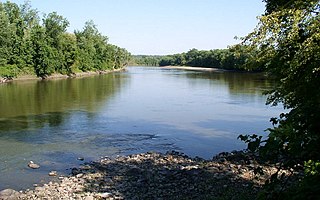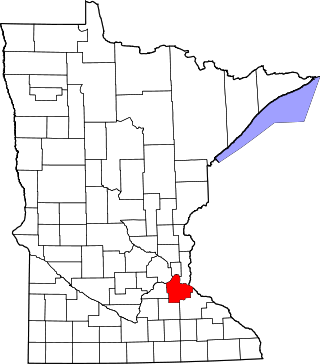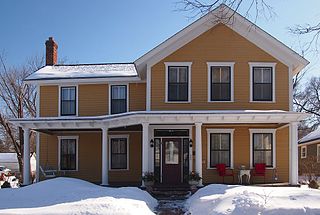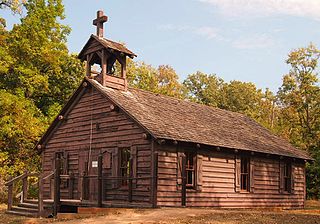
Dakota County is the third-most populous county in the U.S. state of Minnesota, located in the east central portion of the state. As of the 2020 census, the population was 439,882. The population of Dakota County was estimated to be 443,341 in 2022. The county seat is Hastings. Dakota County is named for the Dakota Sioux tribal bands who inhabited the area.

The Jeffers Petroglyphs site is an outcrop in southwestern Minnesota with pre-contact Native American petroglyphs. The petroglyphs are pecked into rock of the Red Rock Ridge, a 23-mile (37 km)-long Sioux quartzite outcrop that extends from Watonwan County, Minnesota to Brown County, Minnesota. The exposed surface is approximately 150 by 650 feet and surrounded by virgin prairie. "The site lies in an area inhabited in the early historic period by the Dakota Indians, and both the style and form of some of the carvings are identical with motifs that appear on Dakota hide paintings and their quill designs and beadwork. Others are foreign to this Plains Indian tradition and seem to be much earlier in origin." Several old wagon trail ruts traverse the site, one of which is believed to be the old stage coach route from New Ulm, Minnesota to Sioux Falls, South Dakota.

The Lower Sioux Agency, or Redwood Agency, was the federal administrative center for the Lower Sioux Indian Reservation in what became Redwood County, Minnesota, United States. It was the site of the Battle of Lower Sioux Agency on August 18, 1862, the first organized battle of the Dakota War of 1862.

Upper Sioux Agency, was a federal administrative center established in response to treaties with the Dakota people in what became Yellow Medicine County, Minnesota, United States. Located on the Minnesota River south of Granite Falls, Minnesota, the government-run campus of employee housing, warehouses and a manual labor school was destroyed in the Dakota War of 1862. The grave of Chief Walking Iron Mazomani, a leader of the Wahpetonwan Dakota tribes, who was killed during the 1862 Dakota War's Battle of Wood Lake, is here. The site was listed on the National Register of Historic Places in 1970 for having state-level significance under the themes of archaeology, architecture, education, and social history. Established as a Minnesota state park in the 60s, the park is being closed and transferred to the tribal members of the Upper Sioux Community. State Route 67, that traverses through the park, was closed after failing deep underground. The highway would require expensive repairs along with the bridge over the Yellow Medicine River that has been compressed by the movement so much that it needs to be removed or replaced.

This is a list of sites in Minnesota which are included in the National Register of Historic Places. There are more than 1,700 properties and historic districts listed on the NRHP; each of Minnesota's 87 counties has at least 2 listings. Twenty-two sites are also National Historic Landmarks.

The Alexander Faribault House is a historic house museum in Faribault, Minnesota, United States. Built in 1853, it was the first wood-frame house constructed in Rice County, Minnesota. It was built by fur trader Alexander Faribault in the Greek Revival style. Besides serving as a house, it also served as a civic center, polling place, and a church. The local address of the house is 12 First Avenue, Faribault, MN. The house was listed on the National Register of Historic Places in 1970.

Traverse des Sioux is a historic site in the U.S. state of Minnesota. Once part of a pre-industrial trade route, it is preserved to commemorate that route, a busy river crossing on it, and a nineteenth-century settlement, trading post, and mission at that crossing place. It was a transshipment point for pelts in fur trading days, and the namesake for an important United States treaty that forced the Dakota people to cede part of their homeland and opened up much of southern Minnesota to European-American settlement.

This is a list of the National Register of Historic Places listings in Dakota County, Minnesota. It is intended to be a complete list of the properties and districts on the National Register of Historic Places in Dakota County, Minnesota, United States. Dakota County is located in the southeastern part of the U.S. state of Minnesota, bounded on the northeast side by the Upper Mississippi River and on the northwest by the Minnesota River. The locations of National Register properties and districts for which the latitude and longitude coordinates are included below, may be seen in an online map.

The MacDonald–Todd House is an 1857 home in Hastings in the U.S. state of Minnesota. The Greek Revival-style house was built by A.W. MacDonald in the utopian town of Nininger when he relocated to Dakota County from New York. He came to become the managing editor of the Emigrant Aid Journal. The paper was owned by Lieutenant Governor Ignatius Donnelly, who also founded the community of Nininger. In 1866, the home was moved across the ice in the Mississippi River to its present location, by Irving Todd, who had bought it for $385.

The Emil J. Oberhoffer House is a historic house in Lakeville, Minnesota, United States, overlooking Orchard Lake. Emil Oberhoffer was the founder and first conductor of the Minneapolis Symphony Orchestra. The home was designed by Paul Haugen, who worked for Purcell and Elmslie, an architectural firm known for its renditions of Prairie School architecture. Later the home belonged to the parents of golfer Patty Berg.

The Good Templars Hall is a Greek Revival style public building that was built in 1858 in Nininger in the U.S. state of Minnesota. The Nininger Chapter of the Independent Order of Good Templars, a temperance group, built the two-story hall to have a place for socializing without alcohol. When the railroad bypassed Nininger in 1859, the town began to fail, and the building was sold to the school district. In the late 1870s the first floor was removed due to decay, and the upper floor and roof were lowered to the ground level. The building was renovated by an historical group and used as a community center until it was moved to the Little Log House Pioneer Village in 2005. A plaque has been erected near its original location.

The Serbian Home is a two-story brick building, that was built in 1924 in South Saint Paul in the U.S. state of Minnesota. It was built as a community center for Serbian immigrants who worked in the meatpacking industry. It served as a museum respecting the multitude of ethnic groups who have made the city their home until 2020, when it was purchased and renovated by Serbian immigrant Aleksandar Stojmenovic to serve as an event center.

The Sioux Quartzite is a Proterozoic quartzite that is found in the region around the intersection of Minnesota, South Dakota, and Iowa, and correlates with other rock units throughout the upper midwestern and southwestern United States. It was formed by braided river deposits, and its correlative units are thought to possibly define a large sedimentary wedge that once covered the passive margin on the then-southern side of the North American craton. In human history, it provided the catlinite, or pipestone, that was used by the Plains Indians to carve ceremonial pipes. With the arrival of Europeans, it was heavily quarried for building stone, and was used in many prominent structures in Sioux Falls, South Dakota and shipped to construction sites around the Midwest. Sioux Quartzite has been and continues to be quarried in Jasper, Minnesota at the Jasper Stone Company and Quarry, which itself was posted to the National Register of Historic Places on January 5, 1978. Jasper, Minnesota contains many turn-of-the-century quartzite buildings, including the school, churches and several other public and private structures, mostly abandoned.

This is a list of the National Register of Historic Places listings in Rock County, Minnesota. It is intended to be a complete list of the properties and districts on the National Register of Historic Places in Rock County, Minnesota, United States. The locations of National Register properties and districts for which the latitude and longitude coordinates are included below, may be seen in an online map.

Birch Coulee Battlefield in Renville County, Minnesota, United States, was the site of the Battle of Birch Coulee, the costliest military engagement for U.S. forces during the Dakota War of 1862. It is now a historic site with self-guided trails and markers interpreting the battle from both sides. Birch Coulee was nominated to the National Register of Historic Places for having state-level significance in military history, and was listed in 1973.

This is a list of the National Register of Historic Places listings in Pope County, Minnesota. It is intended to be a complete list of the properties and districts on the National Register of Historic Places in Pope County, Minnesota, United States. The locations of National Register properties and districts for which the latitude and longitude coordinates are included below, may be seen in an online map.
Waterford is an unincorporated community in Waterford Township, Dakota County, Minnesota, United States.

The Sibley Historic Site is the site of Henry Hastings Sibley's home, who was the regional manager of the American Fur Company and Minnesota's first governor. It is one of the 26 historical sites that are operated by the Minnesota Historical Society. Located in what is now the city of Mendota, the site consists of four limestone buildings and a large lawn area. Three of the buildings are open for touring, including a fur company cold store from 1843 and the 1840 home of fur trader and hotelier Jean-Baptiste Faribault.

Lac qui Parle Mission is a pre-territorial mission in Chippewa County, Minnesota, United States, which was founded in June 1835 by Dr. Thomas Smith Williamson and Alexander Huggins after fur trader Joseph Renville invited missionaries to the area. Lac qui Parle is a French translation of the native Dakota name, meaning "lake which speaks". In the 19th century, the first dictionary of the Dakota language was written, and part of the Bible was translated into that language for the first time at a mission on the site of the park. It was a site for Christian missionary work to the Sioux for nearly 20 years. Renville was related to and had many friends in the Native community, and after his death in 1846, the mission was taken over by the "irreligious" Martin McLeod. The relationship between the mission and the Dakota people worsened, and in 1854 the missionaries abandoned the site and relocated to the Upper Sioux Agency.

The Waterford Bridge, formerly designated Bridge L0327 and now Bridge L3275, is a historic steel truss bridge over the Cannon River in Waterford Township, Minnesota, United States. It was constructed in 1909 and is one of the state's earliest surviving bridges to use rigid rather than pinned connections. Moreover, it is Minnesota's only known road bridge in which some of the rigid connections are fastened with bolts rather than rivets.






















